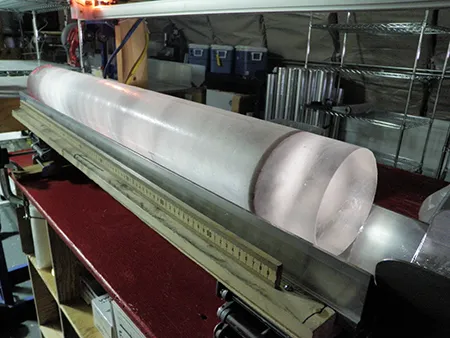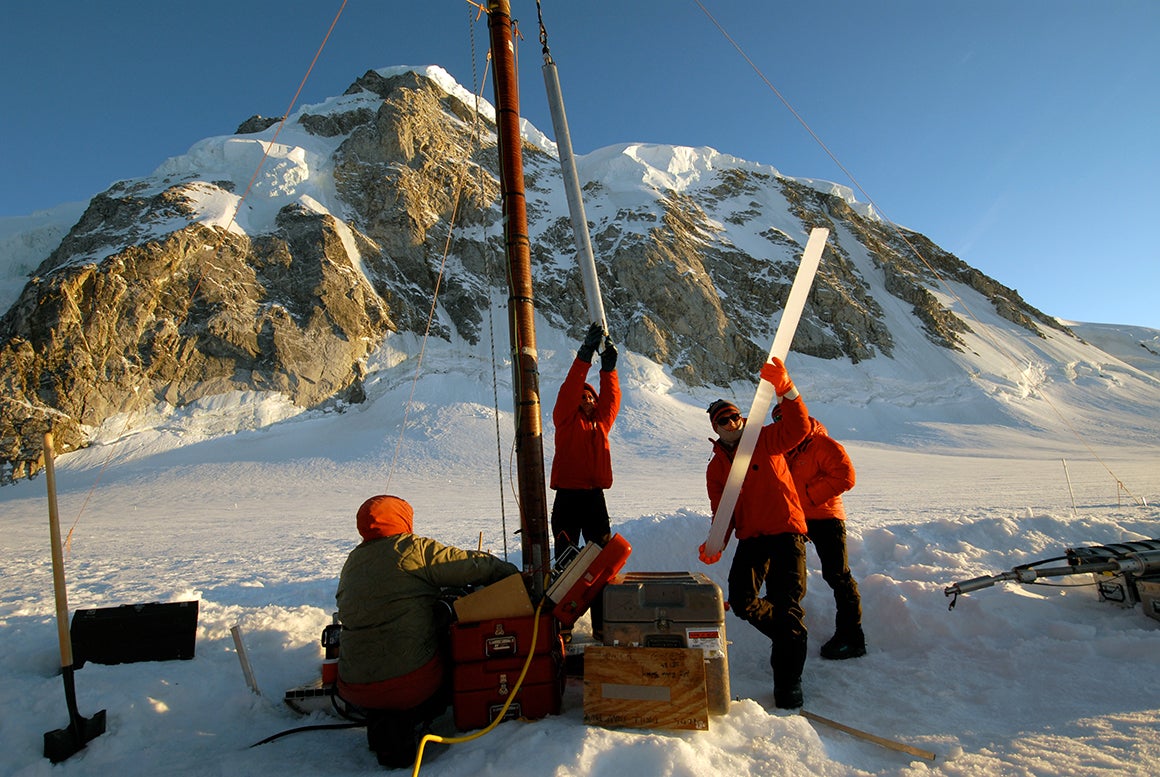Ice Cores Tell the Story of Climate
Ice sheets and glaciers form as layers of snow pile up from one year to the next. Over time the weight of the snow on top compresses the snow below, forming layers of ice. In places where ice sheets and glaciers stay cool enough to prevent melting, the layers of ice provide an uninterrupted record of time. Scientists study ice cores to discover clues about past environments that are trapped within them.
What is an ice core?
An ice core is a long cylinder of ice that is removed from a glacier or ice sheet using specialized equipment. Ice cores have been collected from every continent, but most of them come from Greenland and Antarctica. Many of these ice cores are stored in the National Science Foundation's Ice Core Facility in Colorado. To extract an ice core, researchers set up drilling equipment on the surface of a glacier or ice sheet, and drill down hundreds and even thousands of meters with a special drill that leaves a cylinder of ice undisturbed as it goes through. The longest ice cores collected were over 3 km (2 miles) long! Drilling into the ice allows scientists a glimpse into the climate of the past. The longest ice core record from Greenland extends back 130,000 years ago, and in 2017 an ice core dating back to 2.7 million years ago was recovered in Antarctica.

The dark band in this ice core is a layer of volcanic ash that settled on the West Antarctic Ice Sheet ice sheet approximately 21,000 years ago.
Heidi Roop, NSF
Even though glaciers and ice sheets only form in cold regions, their ice cores contain information about the climate of the entire Earth. Preserved within the ice are bubbles of atmospheric gases, layers of fine particles that settled out of the atmosphere onto the ice, and other dissolved chemicals that provide proxy evidence of how Earth's climate has changed over time.
What is studied in the ice?
- The thickness of an ice layer provides clues about local precipitation; a thick layer corresponds to greater snowfall. Layers in ice cores provide a record of years and seasons. The youngest ice is at the top of an ice core and the oldest ice is at the bottom. Layer thickness may also tell us something about global temperatures, as more snow tends to accumulate at the poles when the climate is warmer.
- Air pockets between the grains of ice become cut off from each other and produce bubbles in the ice. Gas bubbles trapped in the ice can be analyzed in the lab to provide data about past atmospheric composition, including the concentration of greenhouse gases like carbon dioxide.
- Aerosols (extremely fine particles) in the atmosphere are carried by winds around the globe. Some settle on the snow, becoming trapped within ice. These aerosols can include soot produced by burning, ash from volcanic eruptions, and dust from dust storms. Ash from known volcanic eruptions can be used to help calibrate the age of a particular layer of ice.
- Beryllium-10 concentrations, which are linked to the intensity of cosmic rays hitting Earth, are an indirect indicator of solar activity.
- The ratio of concentrations of two isotopes of oxygen in the water molecules in ice serves as an indicator of global temperatures. Oxygen has two commonly occurring natural isotopes, the usual 16O and the less common 18O, which has two extra neutrons. Water molecules that contain 18O are heavier than usual, so they do not evaporate from the ocean as readily as the water molecules that contain 16O. However, when climate is warmer, the temperature of the ocean is warmer and more of the heavier water molecules are able to evaporate and later fall as snow on glaciers and ice sheets. Thus, ice formed in glaciers during warmer times has a higher concentration of 18O than ice formed during cooler times.

Scientists remove a 2-meter section of ice core from the drill site at Combatant Col, British Columbia, from an electrothermal drill.
Credit: Doug Clark, Univ. Washington